LED replacement bulbs, the options get better and cheaper
LED lighting keeps getting better with higher quality light output, better fitting replacement bulbs, and lower costs. While new LED fixtures are a good choice on some boats — note how Gizmo got brighter and dimming cabin lights that way — the options in replacement bulbs have gotten so good that the expense was not justified given my boat’s existing fixtures.
Several years ago I set out to convert as much of Have Another Day’s lighting to LED as possible. With over 100 12v halogen fixtures this was going to be quite an undertaking. The benefit of LEDs in both bulb longevity and efficiency was a benefit worth pursuing. I probably ordered over a dozen different bulbs before settling on a couple of favorites for various applications. With 30 bi-pin G4 halogen fixtures in the salon area alone, cost was a major issue in selecting the winning bulbs. But as Steve Mitchell mentioned in his 2016 LED Lighting article on SailBits, I learned that a constant voltage driver is a must for replacement bulbs with acceptable light output not prone to flickering or other annoying behavior.
The first LED bulbs I purchased came from eBay and cost a couple of dollars a piece. However, they turned out not to be worth even the small price I paid. The light quality was terrible, they flickered and everything looked garish in their light. I then tried some of the more expensive bulbs and while their light quality was much better at $20+ per bulb, I just needed too many of them to justify the expense.
The lineup of bulbs above contains from left to right a three-year-old roughly $20 bulb (marine beam I think), a two-and-a-half-year-old $8 bulb (superbrightleds.com), the $6 single LED Cree bulb (superbrightleds.com), a $3 bulb from Amazon, and a $1.40 bulb from Amazon shaped most like a traditional halogen bulb.
Eventually, like Steve, I decided to use the single Cree LED bulb from superbrightleds.com for much of the lighting on the boat. Despite initial concerns the single LED would emit harsh light, I was pleased with the quality of the light. And, at $5.95 / bulb I could afford enough to convert the most used fixtures without breaking the bank.
There were other areas of the boat where I wanted a little more light than the 60-lumen single LED bulb produced so the second bulb from the left above is a 9-LED, 170-lumen bulb also superbrightleds.com. 170 lumens turns out to be a lot. A 10w halogen bulb is typically rated at about 120 lumens so this is a noticeably brighter bulb.
Having spent several hundred dollars and converted about 60 fixtures, I decided I’d converted enough fixtures and moved onto other projects. But, every time we’re at anchor, and I’m thinking about when I’ll have to fire up the generator, I’m reminded of all the places I haven’t converted to LED. When I returned to Super Bright LEDs to complete my bulb conversion, I learned that both bulbs I’d previously used have been discontinued. But the latest options seem even better.
I’ve noticed the physical configurations of G4-LED-replacement bulbs has changed towards more tower (cylindrical) shaped bulbs and fewer of the flat discs. I’ve previously tried some of the tower-shaped bulbs and had trouble with them fitting in my fixtures. Some perusal of Amazon found what looked like workable disc-shaped bulbs as well as the halogen shaped bulb seen above. At $3/bulb for the flat disc 1.8 watt, 150-lumen bulb and $1.40/bulb for the halogen shaped 1.5 watt, 180-lumen bulb it was easy to give them both a try.
I’m really happy with the light produced by both bulbs and especially happy with the universal fit of the halogen-shaped bulb. This bulb will fit in nearly every fixture I’ve encountered made for standard g4 bulbs and with 6 LEDs on each side of the bulb uses the reflector built into many halogen fixtures. If I need any additional bulbs I think they will be the halogen-shaped bulbs.
I’m keenly aware of the potential RF interference issues from LED bulbs. I haven’t been able to detect any interference from any of the bulbs onboard but when I read the notices about cheap LED bulbs being a large culprit I know they’re talking about me. We rarely boat at night and even more rarely have any lights on. My antennas are all about 8 feet above the overhead in which most of my light fixtures are located.
The Amazon bulbs I ordered this time around aren’t dimmable. For the locations I’m installing them in this time around that’s not a big deal. I do have an LED compatible dimmer in my salon that I use with the 9-LED Super Bright LEDs sourced discs. The dimming is pretty limited with light quality degrading if you dim down too much (and I also fear might well raise the amount of RF noise made). I think this is one area where purpose purpose-built fixtures do a better job than a halogen fixture with an LED bulb.
Have Another Day was clearly designed to either be plugged into shore power or have its honking 23kw generator running at all times the boat is occupied. So, the more than 1,000 watts of potential draw from the lighting wasn’t a major factor. But we don’t like to run the generator any more than we need to and cutting down our draw by 85% or more is a big help in minimizing run time. In fact, after a full year, I just hit the 200-hour service interval for my generator.
- As Ben E. would call it, the booty shot
- One of the many halogen fixtures now converted to LED
- A cheap LED bulb
- the backside of the cheap LED bulb. Notice the much simpler circuitry than the constant voltage drivers



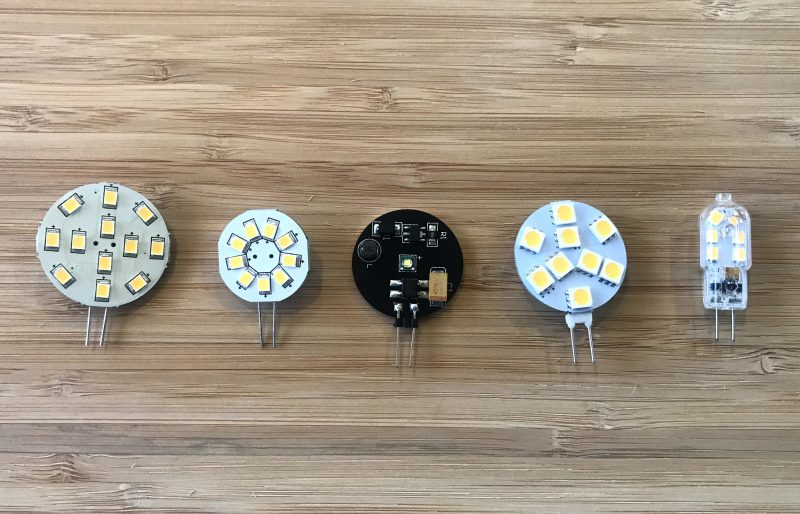
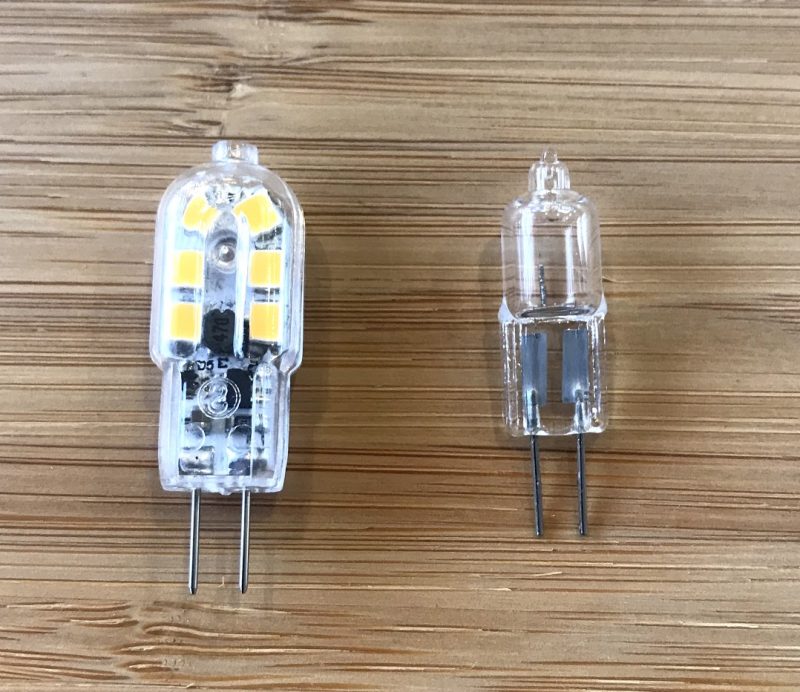
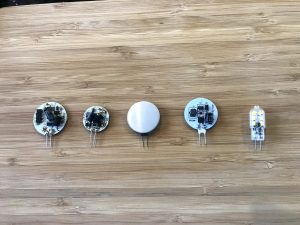
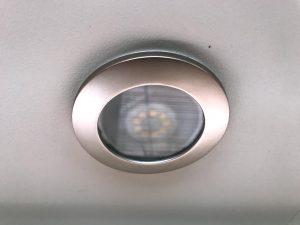
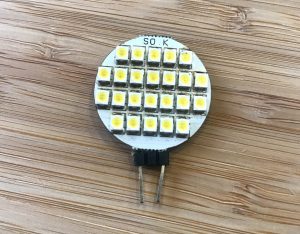
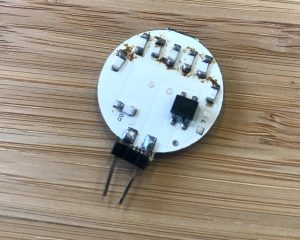
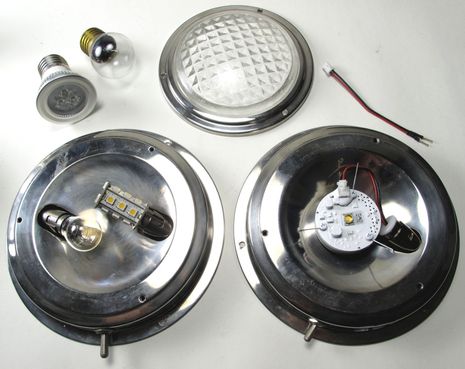










Morning Ben, I’ve been working through the same conversion on Bee Haven. Problem is the “24 volt” system that is more like “28 volts”. Bulbs rated for 12 – 24v often fail on initial energizing or last only days. The only ones I’ve found that last are those rated to 30v from Cruising Solutions. There are over 100 lights so I’m just doing an area at a time.
Hi, Rod. Note that ALL Marinebeam LED replacement bulbs and fixtures use their own constant current driver good for boat DC power input all the way from 10 to 30 volts, and they’ve also posted a good explanation why, with smoking “inexpensive” LED bulb video included 😉
https://store.marinebeam.com/constant-current-1/
Marinebeam’s Jeff Field has also posted an excellent explanation of what’s going with the LED/VHF interference scare:
https://store.marinebeam.com/blog/rf-interference-and-leds/
There’s a brand called NauticLed that makes some great replacement bulbs. They can go 10-35 volts and they have many options of output/color/quality for every lamp kind. It’s a fantastic replacement for halogen and you’ll find that light in cabin improves with less heat and consumption, no dimmed blue poor quality chinese leds. It’s the only “real replacement” that i found for halogens. I know because I have a workshop and some customers asked me to change to led and it was a very hard work to find something that did not look like “chinese rubish”
Thanks, Enrique. Apparently some NauticLED replacement bulbs can even work with the 12 and 24 volt AC fixtures found on some big yachts and ships, though the company seems to work primarily B2B:
https://nauticled.com/
Also, while I don’t doubt that many poor quality LEDs are manufactured in China, that does not mean they can not make good ones, and the 10-for-$14 halogen G4 replacements that Ben Stein writes about above seem to be an example: https://amzn.to/2RvVM61
When we bought the SallyW (37′ LNVT) almost 10 years ago the owner was a bit of a watt nut. So it was almost all led bulbs retro fitted into the old fixtures. It was a pretty dark boat. Over the years I have replaced most of the old leds and improved the light quality and quantity .If you visited the boat you would not think it was a dark boat. Even installed Hella running lights which I highly recommend . We are able to get by with only 1 8D battery with 2 small fridges. I can go 2 nights on the hook without running the battery down 1/2 . I have no led drivers only bulbs and therefor no noise. Most of us are still changing bulbs to as they get better looking . The future is not looking dim! Start changing bulbs on your boat as we all have done at home.
Good morning Allan, just one note of clarification on the LED drivers. Each retrofit bulb you have installed will have some form of driver built into the bulb. These drivers are voltage transformers. The Marinebeam article on RF that Ben E. posted above also does a nice job explaining the need for drivers and why they can produce RF interference.
Ben, the Marinebeam LED drivers are not “voltage transformers”, but rather constant-current drivers. LEDs care about current. Besides, “transformers” only work on AC. Faraday’s law of inductance insists upon that. Most drivers these days are some sort of switch-mode power supply, or linear regulator. The Marinebeam G4 bulbs also include a transient voltage suppressor and a PTCC thermal foldback device. The former protects the electronics from ESD, and the latter folds back the current in the case the bulb begins to reach an over-temp or thermal runaway situation.
As usual your right Ben I sort of know that but they are so small its hard to remember.
I was going to make a rude comment about boats with 100+ overhead lights – and then I counted fixtures on Atsa… Not near 100, but way more than I would have guessed without counting. I went thru the same process you did, Ben – I started with some cheep eBay Chinese (I think there’s one left from this era, in an area seldom entered) and progressing to Marine-store “LED replacements” (mostly for nav lights) and I’ve settled on Marinebeam – their bulbs just keep on working, and for nav lights and the ones we use every day, that’s essential. I do note that their prices are much lower than they were a few years ago. I have been particularly impressed with the LED replacement “tubes” for fluorescent fixtures.
On those “drivers” – in actuality, they are current limiters/regulators, not voltage regulators.
Three years ago I converted all the lights in my boat to LEDs. I used these inexpensive bulbs on all the overhead fixtures and I’ve been very pleased with them. The pins on the bulbs were a bit too long, causing them to stick out too much and interfering with the lens. That was easily remedied by shortening the pins with diagonal cutters. I also had 2-3 bulbs DOA and the supplier replaced them immediately.
https://www.eversale.com/catalog2_1/product_info.php/tiny-omnidirectional-lamp-bulb-p-255.
Incidentally, I recently replaced all the light fixtures in the engine compartment with LED fixtures designed for trucks and RVs. These lights create interference with the FM stereo, but not with the VHF comm. It’s not a big deal because the lights are only on when I’m working on the engines.
Hi,
I am using halogen shaped 1.5 watt, 180-lumen bulb, mentioned above, on my boat for the year and a half. They work really good, but some of them (2 out of 18) died after one year. However considering the price, i think it is not a such a big deal. Also they do not cause any interference with VHF radio.
Also I am using the red colored LED bulbs, from the same manufacturer. They are bit worse and one of them died only after 10 month. Again, considering the price, it is not such a big deal.
We replaced all (most) of our LED lights on our Carver 450 Voyager with these: https://smile.amazon.com/LEORX-180LM-3000-3500K-24-LED-Bulbs/dp/B01GJD7HOS/ref=sr_1_1?s=hi&ie=UTF8&qid=1547140083&sr=1-1&keywords=leorx
They have worked out great. Inexpensive and we like the light they put out. The only draw back to them is in our salon. We have a dimmer and if you replace all of the bulbs they won’t dim. So we left one halogen. It isn’t that noticeable and does not bother us.
One big advantage to going halogen is the draw on our batteries. Hubby used to have to fill them 2-3 times a year; now they lose very little fluid over a full summer.
Hi Ben,
Thanks for the interesting article. Worth nothing that converting ALL lights to LED isn’t always worth it. We have lights in the some areas (e.g., forepeak and hanging locker) that are turned on maybe a total of 5 hours in a year. The energy savings are so minimal that it doesn’t make sense to put new bulbs in. We’ve met several cruisers who go through their whole boat changing every bulb. But that could add to RF woes (with the wrong bulb) and it doesn’t always make economic or electrical-savings sense.
Hello, this is a follow up question on the above article. I tried replacing salon/head lights with LEDs (some MarineBeam, others from amazon). My boat had all 20w halogen G4 bulbs running from Jefferson electric Powerformers (low voltage transformers). Some of the LED’s worked, some didn’t and blew right away. The ones that didn’t blow right away, did so shortly thereafter, so I am stumped. Do I need to replace the JE powerformers to constant drivers? Is it a polarity issue? thx for any help.
Hi Neal,
Marinebeam LED bulbs are for 10-30 volts DC. They are designed to operate on DC at either 12V or 24V. The fact that you have said that you are using a transformer means that you are operating your LEDs on AC rather than DC. We know this because transformers will not work at all on DC. Faraday’s Law of Inductance prohibits it. So, you are just stepping down an AC voltage from say 120VAC to say 24VAC. So, there is nothing wrong with the bulbs, or your transformer, but they are just not the right selection for your application. The good news is that your issue is easily solved. We can help you select a DC/DC converter to inexpensively solve the problem permanently. Just contact me at jeff(at)marinebeam.com.
It’s been a little over a year since I wrote this article. I’m still pretty happy with the least expensive bulbs on the boat, those from Amazon. I’ve had two of the roughly 20 bulbs I bought fail and had I spent much more than a dollar or two a bulb I might have been annoyed. But, at the price I paid a 10% failure rate is acceptable to me.
I haven’t experienced any noticeable issues with noise coming from the bulbs causing any issues with VHF or any other radios.
-Ben S.